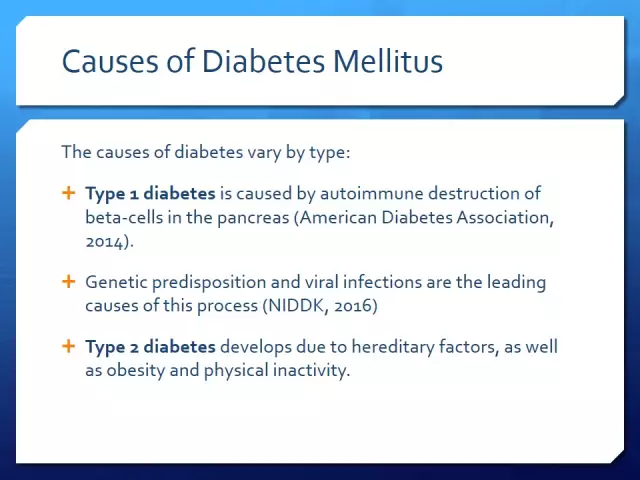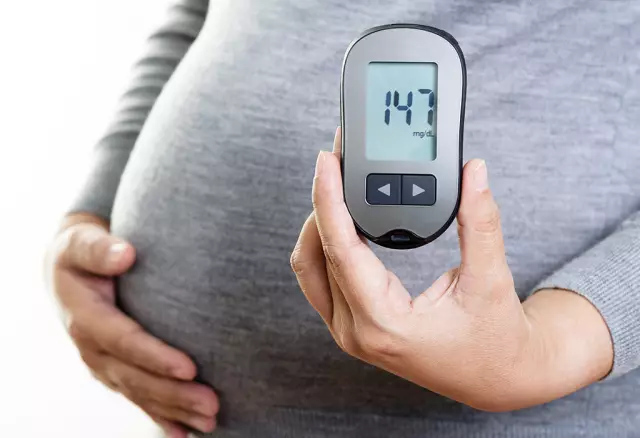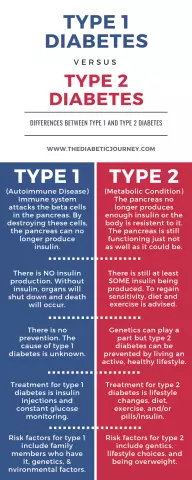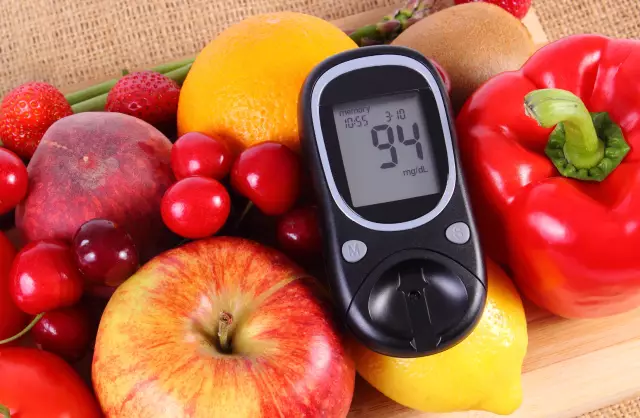- Author Rachel Wainwright [email protected].
- Public 2023-12-15 07:39.
- Last modified 2025-11-02 20:14.
Diabetes
General characteristics of the disease
Diabetes mellitus is one of the most common diseases in the world. More often than diabetes mellitus, only cardiovascular and oncological pathologies are diagnosed annually. According to rough estimates, 3% of the world's population suffers from diabetes mellitus today. And according to the forecasts of doctors in 15-20 years, a twofold increase in people with diabetes is expected.
The causes of diabetes

The main cause of diabetes mellitus is disorders of carbohydrate metabolism in the body. This phenomenon is due to one of two factors: either the body is not able to perceive insulin, or its amount does not cover the needs of a person.
There are many theories about the causes of diabetes. One of them is the hereditary etiology of the disease. Familial predisposition to pathology occurs in type I diabetes mellitus. It is provoked by a viral infection (influenza, measles or mumps), activating the process of destruction of insulin-forming cells in the body.
A hereditary cause of diabetes mellitus is also possible with type II disease. But in this case, the disease is caused by the congenital immunity of body tissues to insulin. In a family with a predisposition to type I disease, diabetes mellitus occurs in 7-10% of relatives, and in type II diabetes, the probability of getting sick is already 80-100%.
Overweight of the patient and diseases of the pancreas are also called among the causes of diabetes mellitus: malignant neoplasms of the organ or pancreatitis.
A possible cause of diabetes mellitus can also be an injury that damaged the tissues of the pancreas and disrupted its functions. In addition, the causes of diabetes mellitus include stress and the elderly age of the patient. The likelihood of getting sick increases 2 times with each passing decade.
The abuse of sweets, as one of the possible causes of diabetes mellitus, is not seriously considered by doctors, but exactly as long as the addiction to sugar does not lead a person to obesity or diseases of the pancreas.
Types of diabetes
Type I diabetes mellitus, as already mentioned, develops as a result of the destruction of insulin-forming cells. This disease is typical for young people.
One of the first symptoms of type I diabetes mellitus is frequent urination. This is how the human body tries to remove excess glucose. Polyuria leads to intense thirst and high fluid intake.
In type I diabetes mellitus, the patient suffers from increased stress on the kidneys, dehydration and the accumulation of ketone bodies. Ketoacidosis, as one of the complications of diabetes mellitus, can lead the patient to a state of diabetic precoma or coma.
Type II diabetes mellitus occurs much more often than type I disease. The risk group includes patients who are overweight or over 40 years old.
In this type of diabetes, the human body produces normal amounts of insulin. But, despite this, the patient's blood contains an increased amount of glucose. In type II diabetes mellitus, the patient's body has low insulin resistance, i.e. poor sensitivity to the effects of insulin.
The severity of the symptoms of type II diabetes mellitus depends on the degree of tissue insensitivity to insulin. According to the severity of the course of the disease, it is customary to distinguish mild, moderate and severe degree II type of diabetes mellitus.
The pancreatic type of diabetes mellitus develops due to damage to the tissues of the pancreas in pancreatitis, tumors, as well as as a result of the consequences of unsuccessful surgery, trauma or alcohol abuse.
Symptoms of diabetes
Among the main symptoms of diabetes of both types are called:
- increased urination,
- increased thirst
- fatigue.
- dry and itchy skin
- weight loss,
- cramps in calves
- decreased vision clarity.

At the initial stage of the disease, the severity of symptoms of diabetes mellitus is usually not significant. In the future, with the progression of hyperglycemia, there is a likelihood of situations of a sharp increase in blood glucose levels and the development of critical conditions requiring emergency medical care.
Diagnosis of diabetes mellitus
The diagnosis of the disease is established on the basis of the classic symptoms of diabetes mellitus and laboratory test data. In diagnosing diabetes, the patient's blood glucose level is checked. In case of controversy, glucose stress tests are recommended.
According to the norms, in a healthy person, blood glucose values do not exceed 6.6 mmol / L on an empty stomach and 11.1 mmol / L after a meal. The presence of sugar in the patient's urine is another diagnostic symptom of diabetes mellitus.
Diabetes mellitus treatment
Treatment of diabetes mellitus is symptomatic. It includes diet therapy, drug therapy and exercise therapy. The main goal of treatment for diabetes mellitus is to normalize metabolic processes in the body and maintain the patient's performance.
Type II diabetes mellitus is called non-insulin dependent. The main role in the treatment of this type of diabetes mellitus is played by diet and exercise to normalize weight.
In the initial stages of the disease, it is possible to restore carbohydrate metabolism in the body with the help of weight loss. The recommended diet for overweight patients is a minimum of easily digestible carbohydrates and high-calorie foods, refusal of canned foods, smoked meats, fatty meats, mayonnaise, sour cream, nuts, ice cream, jam, sweets, etc.
Exercise, as one of the auxiliary methods of treating diabetes mellitus, helps to lower blood glucose levels, increase insulin production and tissue sensitivity to it.
In the later stages of the disease, in the treatment of type II diabetes mellitus, drugs are used that increase the sensitivity of tissues to insulin and inhibit the function of the intestine to break down glucose: Biguanides, Thiazolidinediones, α-glycosidase inhibitors, etc.
Insulin is used in the treatment of type I diabetes. There are insulin preparations of different duration of action: short, intermediate and long. The frequency of injections of the drug, designed to replace the function of the pancreas to produce its own insulin, depends on the time of action of the drug.
Treatment of type I diabetes mellitus with insulin is life-long. An important part of disease therapy is teaching the patient the skills to control blood glucose levels and the ability to self-inject insulin.
The treatment regimen for diabetes mellitus is drawn up individually for each patient, taking into account his condition, weight and age. Independent uncontrolled treatment of diabetes mellitus with insulin is extremely dangerous to health.
Alternative treatment of diabetes mellitus
The following recipes for alternative treatment of diabetes mellitus have proven themselves well as auxiliary methods to the main therapy of the disease:
- Collection of birch buds, hawthorn fruits, veronica leaves, centaury and burdock in proportions 2: 3: 1: 5: 5.
- Medicinal collection of lingonberry leaves, St. John's wort, corn stigmas, mint, dried cress and blueberry leaves in proportions of 2: 4: 2: 2: 4: 1.

The collection of licorice roots, blueberry leaves and juniper fruits, taken in equal quantities, is also widely used in the folk treatment of diabetes mellitus.
The effective methods of alternative treatment of diabetes mellitus include the collection of the bark of elderberry, veronica, shepherd's purse, horsetail of the field fruits of sophora, hawthorn and rose hips, also taken in equal proportions.
All of the above compounds used in the traditional treatment of diabetes mellitus help to normalize carbohydrate metabolism in the body and prevent the appearance of nephrological and ophthalmic complications of the disease.
YouTube video related to the article:
The information is generalized and provided for informational purposes only. At the first sign of illness, see your doctor. Self-medication is hazardous to health!






